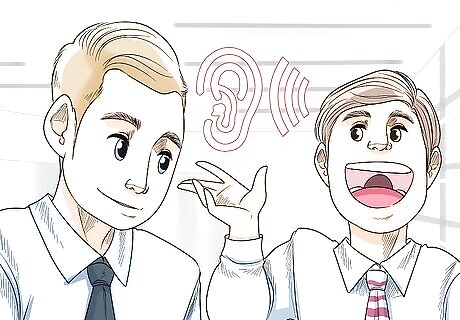
views
Mirroring Body Language

Shadow the placement and movement of the other person’s hands. Watch to see if they are hanging their arms loosely at their sides or frantically gesturing in the air while talking. Try to incorporate some of these movements into your own style. This might mean moving your hands more or maybe keeping them more still. For example, if you are talking with someone who keeps their hands buried in their pockets, then mirror this movement.

Follow the other person’s posture. Look at your conversation partner, or the entire group, to see if they are acting casual or more formal. Are their spines straight and heads at attention? Or, are they leaning in various relaxed positions? Mirror the formality of the other people who you are around to show that you fit in. If you’re in a meeting and everyone else is sitting up straight in their chairs, then scoot a little forward in your chair and straighten your spine. If your conversation partner is standing with their arms crossed, then you’ll want to weigh whether or not you want to appear equally closed off before copying their posture.

Match the other person’s breathing patterns. This is a more subtle way to get in sync with a conversation partner. Observe them closely to see if they are breathing from deep in their chest or more shallowly from their diaphragm. Try to match the pace of their inhalations and exhalations. You’ll also find that this helps to create natural breaks and pauses in the conversation.

Meet the energy level of the other person(s). If the person you are talking to is more shy and retiring, then talking with them in a hyper or enthusiastic way could be overwhelming for them. Similarly, if you are talking with an exuberant person, then being very soft-spoken might lead to one-sided conversation. This doesn’t mean that you must change your entire personality or way of interacting. Instead, try to strike a balance that lets you bond with the other person successfully. For example, if your conversation partner tends to speak softly when discussing serious matters, follow their lead if you have something important to add.

Mimic the tone and volume of your conversation partner(s). A person who speaks in quiet, soft tones can feel steamrolled by a loud and boisterous counterpart. Raise or lower your voice until you notice that the person who you are talking to is actually paying attention to what you are saying. If your partner is a fast-talker, you may need to speed up, too. In some situations, the other person may be talking softly out of respect for their surroundings, such as in a museum or church. Showing the same situational respect is a way to instantly build rapport.
Building Rapport through Conversation

Mention an end to the conversation. This is especially important if you are talking with a stranger or acquaintance. Work into the conversation a mention of needing to be elsewhere soon. This will make the other person not feel obligated to talk for a long while, which will actually build rapport between you both. For example, in a work setting, you might say, “I have a meeting in 5 minutes, but I was wondering if you’d heard anything from human resources about the possibility of new hires.” In a casual or social setting, you might say, “I’ve got to rush to finish these errands, but just wanted to see if you have any news about the Smith family.” There are possible exceptions to this suggestion. For example, you might want to intentionally linger if you are meeting with friends or talking with a client who has questions to ask.

Ask for assistance. Come up with a small task that the other person could help you with. Then, bring it up to them and ask for their help. This will make them feel needed and important. It may also lead to them requesting a favor from you as well, which can further build your connection. For example, ask a co-worker to forward on that group email that you seem to have missed. However, don’t go overboard in asking for help by making many requests or you may seem too needy. A good general rule is to avoid asking for more than you would be willing to offer in return.

Avoid correcting other people in conversation. Unless it is a very serious issue that requires an immediate correction by you, just give whoever you are talking to a bit of slack. If you correct every error, then you risk alienating others and appearing superior or arrogant. For example, if the person who you are talking to mispronounces a celebrity name, just let it go.

Listen to someone talking without always responding. Let the other person say their piece and just sit back and listen. Show that you are engaged in what they are saying by nodding your head or encouraging them to continue at intervals. As soon as they pause, resist the urge to jump right in with your own story. Steering the conversation back to them demonstrates that you are genuinely interested in what they have to say and want to know more. You might say, “Could you tell me more about your trip to the Cincinnati office?” On a similar note, being visually present by putting your phone away or focusing on one conversation at a time can help someone feel listened to.

Intermix open-ended questions into conversation. These are questions that push for answers beyond a basic “yes” or “no.” They encourage people to expand on their previous responses. They also show that you are listening closely and carefully. Questions that start with “How?” or “Why?” are generally the best. For example, you might ask, “Why did you make that decision to move abroad?”
Developing a Relationship

Offer a small tangible or intangible gift. It doesn’t really matter what the gift is, as long as it is thoughtful and positive. It can be an item, such as a piece of candy, or something intangible, like a positive reference. The key here is to create a deeper relationship. In many cases, your gift will prompt them to communicate more with you or even offer their own gift. For example, if someone is new to your office, you might give them a fresh set of stationery for their desk.

Be trustworthy. If you promise something, no matter how small, make sure that you follow through with it. Better yet, communicate your timeline to the other person. Building rapport is closely connected to building trust. If you are trustworthy, other people will see you as “safe” and will want to spend time and do business with you. For example, if you are a salesperson, make sure to carefully describe your product so that the customer knows exactly what they are getting. Then, you’ll get repeat customers.

Build your relationship slowly. If you push to become best friends instantly, then you will likely scare the other person away. Instead, enjoy each small step in your budding friendship and take your time. This is also important from a cultural perspective. Some cultures see it as outright insulting to discuss personal matters during initial meetings. As a general rule, let the other person’s degree of disclosure serve as your guide. If they delve into personal subjects, then you can, too.

















Comments
0 comment